Open videostereo.m in the Editor
Run in the Command Window
Stereo Vision
Stereo vision is the process of recovering depth from camera images by comparing two or
more views of the same scene. Simple, binocular stereo uses only two images, typically taken
with parallel cameras that were separated by a horizontal distance known as the "baseline."
The output of the stereo computation is a disparity map (which is translatable to a range
image) which tells how far each point in the physical scene was from the camera.
In this demo, we use MATLAB® and the Video and Image Processing Blockset™ to
compute the depth map between two rectified stereo images. See the Image Rectification
Demo to learn about the details behind rectification. In this demo we use block matching,
which is the standard algorithm for highspeed stereo vision in hardware systems [8]. We first
explore basic block matching, and then apply dynamic programming to improve accuracy,
and image pyramiding to improve speed.
This demo is similar to the Simulink Estimation for Stereo Vision Demo. The main
difference is that the Simulink demo does not assume it has been given rectified images, and
so searches along general epipolar lines that are not necessarily parallel to the xaxis.
Contents
Step 1. Read stereo image pair
Step 2. Basic block matching
Step 3. Subpixel estimation
Step 4. Dynamic programming
Step 5. Image Pyramiding
Step 6. Combined pyramiding and dynamic programming
Step 7. Backprojection
References
Step 1. Read stereo image pair
Here we read in the color stereo image pair and convert the images to grayscale for the
matching process. Using color images may provide some improvement in accuracy, but it is
more efficient to work with only onechannel images. For this we use the
ImageDataTypeConverter and the ColorSpaceConverter System objects. Below we show the
left camera image and a color composite of both images so that one can easily see the
disparity between them.
hIdtc = video.ImageDataTypeConverter;
hCsc = video.ColorSpaceConverter('Conversion','RGB to intensity');
leftI3chan = step(hIdtc,imread('vipstereo_hallwayLeft.png'));
leftI = step(hCsc,leftI3chan);
rightI3chan = step(hIdtc,imread('vipstereo_hallwayRight.png'));
rightI = step(hCsc,rightI3chan);
figure(1), clf;
imshow(rightI3chan), title('Right image');
figure(2), clf;
imshow(cat(3,rightI,leftI,leftI)), axis image;
title('Color composite (right=red, left=cyan)');
�
Step 2. Basic block matching
Next we perform basic block matching. For every pixel in the right image, we extract the 7
by7pixel block around it and search along the same row in the left image for the block that
best matches it. Here we search in a range of
pixels around the pixel's location in the first
image, and we use the sum of absolute differences (SAD) to compare the image regions. We
need only search over columns and not over rows because the images are rectified. We use
the TemplateMatcher System object to perform this block matching between each block and
the region of interest.
�
Dbasic = zeros(size(leftI), 'single');
disparityRange = 15;
% Selects (2*halfBlockSize+1)‐by‐(2*halfBlockSize+1) block.
halfBlockSize = 3;
blockSize = 2*halfBlockSize+1;
% Allocate space for all template matchers.
tmats = cell(blockSize);
% Scan over all rows.
for m=1:size(leftI,1)
% Set min/max row bounds for image block.
minr = max(1,m‐halfBlockSize);
maxr = min(size(leftI,1),m+halfBlockSize);
% Scan over all columns.
for n=1:size(leftI,2)
minc = max(1,n‐halfBlockSize);
maxc = min(size(leftI,2),n+halfBlockSize);
% Compute disparity bounds.
mind = max( ‐disparityRange, 1‐minc );
maxd = min( disparityRange, size(leftI,2)‐maxc );
% Construct template and region of interest.
template = rightI(minr:maxr,minc:maxc);
templateCenter = floor((size(template)+1)/2);
roi = [minr+templateCenter(1)‐2 ...
minc+templateCenter(2)+mind‐2 ...
1 maxd‐mind+1];
% Lookup proper TemplateMatcher object; create if empty.
if isempty(tmats{size(template,1),size(template,2)})
tmats{size(template,1),size(template,2)} = ...
video.TemplateMatcher('ROIInputPort',true);
end
thisTemplateMatcher = tmats{size(template,1),size(template,2)};
% Run TemplateMatcher object.
loc = step(thisTemplateMatcher, leftI, template, roi);
Dbasic(m,n) = loc(2) ‐ roi(2) + mind;
end
end
In the results below, the basic block matching does well, as the correct shape of the stereo
scene is recovered. However, there are noisy patches and bad depth estimates everywhere,
especially on the ceiling. These are caused when no strong image features appear inside of
the 7by7pixel windows being compared. Then the matching process is subject to noise
since each pixel chooses its disparity independently of all the other pixels.
For display purposes, we saturate the depth map to have only positive values. In general,
slight angular misalignment of the stereo cameras used for image acquisition can allow both
positive and negative disparities to appear validly in the depth map. In this case, however, the
stereo cameras were near perfectly parallel, so the true disparities have only one sign. Thus
this correction is valid.
figure(3), clf;
imshow(Dbasic,[]), axis image, colormap('jet'), colorbar;
caxis([0 disparityRange]);
title('Depth map from basic block matching');
�
Step 3. Subpixel estimation
The disparity estimates returned by block matching are all integervalued, so the above depth
map exhibits contouring effects where there are no smooth transitions between regions of
different disparity. This can be ameliorated by incorporating subpixel computation into the
matching metric. Previously we only took the location of the minimum cost as the disparity,
but now we take into consideration the minimum cost and the two neighboring cost values.
We fit a parabola to these three values, and analytically solve for the minimum to get the sub
pixel correction.
DbasicSubpixel= zeros(size(leftI), 'single');
tmats = cell(2*halfBlockSize+1);
for m=1:size(leftI,1)
% Set min/max row bounds for image block.
minr = max(1,m‐halfBlockSize);
maxr = min(size(leftI,1),m+halfBlockSize);
% Scan over all columns.
for n=1:size(leftI,2)
minc = max(1,n‐halfBlockSize);
maxc = min(size(leftI,2),n+halfBlockSize);
% Compute disparity bounds.
mind = max( ‐disparityRange, 1‐minc );
maxd = min( disparityRange, size(leftI,2)‐maxc );
% Construct template and region of interest.
template = rightI(minr:maxr,minc:maxc);
templateCenter = floor((size(template)+1)/2);
roi = [minr+templateCenter(1)‐2 ...
minc+templateCenter(2)+mind‐2 ...
1 maxd‐mind+1];
% Lookup proper TemplateMatcher object; create if empty.
if isempty(tmats{size(template,1),size(template,2)})
tmats{size(template,1),size(template,2)} = ...
video.TemplateMatcher('ROIInputPort',true,...
'BestMatchNeighborhoodOutputPort',true);
end
�
thisTemplateMatcher = tmats{size(template,1),size(template,2)};
% Run TemplateMatcher object.
[loc,a2] = step(thisTemplateMatcher, leftI, template, roi);
ix = single(loc(2) ‐ roi(2) + mind);
% Subpixel refinement of index.
DbasicSubpixel(m,n) = ix ‐ 0.5 * (a2(2,3) ‐ a2(2,1)) ...
/ (a2(2,1) ‐ 2*a2(2,2) + a2(2,3));
end
end
Rerunning basic block matching, we achieve the result below where the contouring effects
are mostly removed and the disparity estimates are correctly refined. This is especially
evident along the walls.
figure(1), clf;
imshow(DbasicSubpixel,[]), axis image, colormap('jet'), colorbar;
caxis([0 disparityRange]);
title('Basic block matching with sub‐pixel accuracy');
Step 4. Dynamic programming
As mentioned above, basic block matching creates a noisy disparity image. This can be
improved by introducing a smoothness constraint. Basic block matching chooses the optimal
disparity for each pixel based on its own cost function alone. Now we want to allow a pixel
to have a disparity with possibly suboptimal cost for it locally. This extra cost must be offset
by increasing that pixel's agreement in disparity with its neighbors. In particular, we constrain
each disparity estimate to lie with
values of its neighbors' disparities, where its neighbors
are the adjacent pixels along an image row. The problem of finding the optimal disparity
estimates for a row of pixels now becomes one of finding the "optimal path" from one side of
the image to the other. To find this optimal path, we use the underlying block matching
metric as the cost function and constrain the disparities to only change by a certain amount
�
between adjacent pixels. This is a problem that can be solved efficiently using the technique
of dynamic programming [3,4].
Ddynamic = zeros(size(leftI), 'single');
finf = 1e3; % False infinity
disparityCost = finf*ones(size(leftI,2), 2*disparityRange + 1, 'single');
disparityPenalty = 0.5; % Penalty for disparity disagreement between pixels
% Scan over all rows.
for m=1:size(leftI,1)
disparityCost(:) = finf;
% Set min/max row bounds for image block.
minr = max(1,m‐halfBlockSize);
maxr = min(size(leftI,1),m+halfBlockSize);
% Scan over all columns.
for n=1:size(leftI,2)
minc = max(1,n‐halfBlockSize);
maxc = min(size(leftI,2),n+halfBlockSize);
% Compute disparity bounds.
mind = max( ‐disparityRange, 1‐minc );
maxd = min( disparityRange, size(leftI,2)‐maxc );
% Compute and save all matching costs.
for d=mind:maxd
disparityCost(n, d + disparityRange + 1) = ...
sum(sum(abs(leftI(minr:maxr,(minc:maxc)+d) ...
‐ rightI(minr:maxr,minc:maxc))));
end
end
% Process scanline disparity costs with dynamic programming.
optimalIndices = zeros(size(disparityCost), 'single');
cp = disparityCost(end,:);
for j=size(disparityCost,1)‐1:‐1:1
% False infinity for this level
cfinf = (size(disparityCost,1) ‐ j + 1)*finf;
% Construct matrix for finding optimal move for each column
% individually.
[v,ix] = min([cfinf cfinf cp(1:end‐4)+3*disparityPenalty;
cfinf cp(1:end‐3)+2*disparityPenalty;
cp(1:end‐2)+disparityPenalty;
cp(2:end‐1);
cp(3:end)+disparityPenalty;
cp(4:end)+2*disparityPenalty cfinf;
cp(5:end)+3*disparityPenalty cfinf cfinf],[],1);
cp = [cfinf disparityCost(j,2:end‐1)+v cfinf];
% Record optimal routes.
optimalIndices(j,2:end‐1) = (2:size(disparityCost,2)‐1) + (ix ‐ 4);
end
% Recover optimal route.
[~,ix] = min(cp);
Ddynamic(m,1) = ix;
for k=1:size(Ddynamic,2)‐1
Ddynamic(m,k+1) = optimalIndices(k, ...
max(1, min(size(optimalIndices,2), round(Ddynamic(m,k)) ) ) );
end
end
Ddynamic = Ddynamic ‐ disparityRange ‐ 1;
The image below shows the stereo result refined by applying dynamic programming to each
row individually. Dynamic programming does introduce errors of its own by blurring the
edges around object boundaries due to the smoothness constraint. Also, it does nothing to
smooth ''between'' rows, which is why a striation pattern now appears on the left side
foreground chair. Despite these limitations, the result is significantly improved, with the
�
noise along the walls and ceiling nearly completely removed, and with many of the
foreground objects being better reconstructed.
figure(3), clf;
imshow(Ddynamic,[]), axis image, colormap('jet'), colorbar;
caxis([0 disparityRange]);
title('Block matching with dynamic programming');
Step 5. Image Pyramiding
While dynamic programming can improve the accuracy of the stereo image, basic block
matching is still an expensive operation, and dynamic programming only adds to the burden.
One solution is to use image pyramiding and telescopic search to guide the block matching
[5,7]. With the fullsize image, we had to search over a
disparities in the image. If we had downsized the image by a factor of two, however, this
search could have been reduced to
pixels on an image a quarter of the area, meaning this
step would cost a factor of 8 less. Then we use the disparity estimates from this downsized
operation to seed the search on the larger image, and therefore we only need to search over a
smaller range of disparities.
pixel range to properly detect the
The below example performs this telescoping stereo matching using a threelevel image
pyramid. We use the Pyramid and GeometricScaler System objects, and we have wrapped up
the preceding block matching code into the function vipstereo_blockmatch.m for simplicity.
The disparity search range is only
compute than basic block matching. Yet the results compare favorably.
pixels at each level, making it over 5x faster to
% Construct a three‐level pyramid
pyramids = cell(1,4);
pyramids{1}.L = leftI;
pyramids{1}.R = rightI;
for i=2:length(pyramids)
hPyr = video.Pyramid('PyramidLevel',1);
pyramids{i}.L = single(step(hPyr,pyramids{i‐1}.L));
�
pyramids{i}.R = single(step(hPyr,pyramids{i‐1}.R));
end
% Declare original search radius as +/‐4 disparities for every pixel.
smallRange = single(3);
disparityMin = repmat(‐smallRange, size(pyramids{end}.L));
disparityMax = repmat( smallRange, size(pyramids{end}.L));
% Do telescoping search over pyramid levels.
for i=length(pyramids):‐1:1
Dpyramid = vipstereo_blockmatch(pyramids{i}.L,pyramids{i}.R, ...
disparityMin,disparityMax,...
false,true,3);
if i > 1
% Scale disparity values for next level.
hGsca = video.GeometricScaler(...
'InterpolationMethod','Nearest neighbor',...
'SizeMethod','Number of output rows and columns',...
'Size',size(pyramids{i‐1}.L));
Dpyramid = 2*step(hGsca, Dpyramid);
% Maintain search radius of +/‐smallRange.
disparityMin = Dpyramid ‐ smallRange;
disparityMax = Dpyramid + smallRange;
end
end
figure(3), clf;
imshow(Dpyramid,[]), colormap('jet'), colorbar, axis image;
caxis([0 disparityRange]);
title('Four‐level pyramid block matching');
Step 6. Combined pyramiding and dynamic programming
Finally we merge the above techniques and run dynamic programming along with image
pyramiding, where the dynamic programming is run on the disparity estimates output by
every pyramid level. The results compare well with the highestquality results we have
�


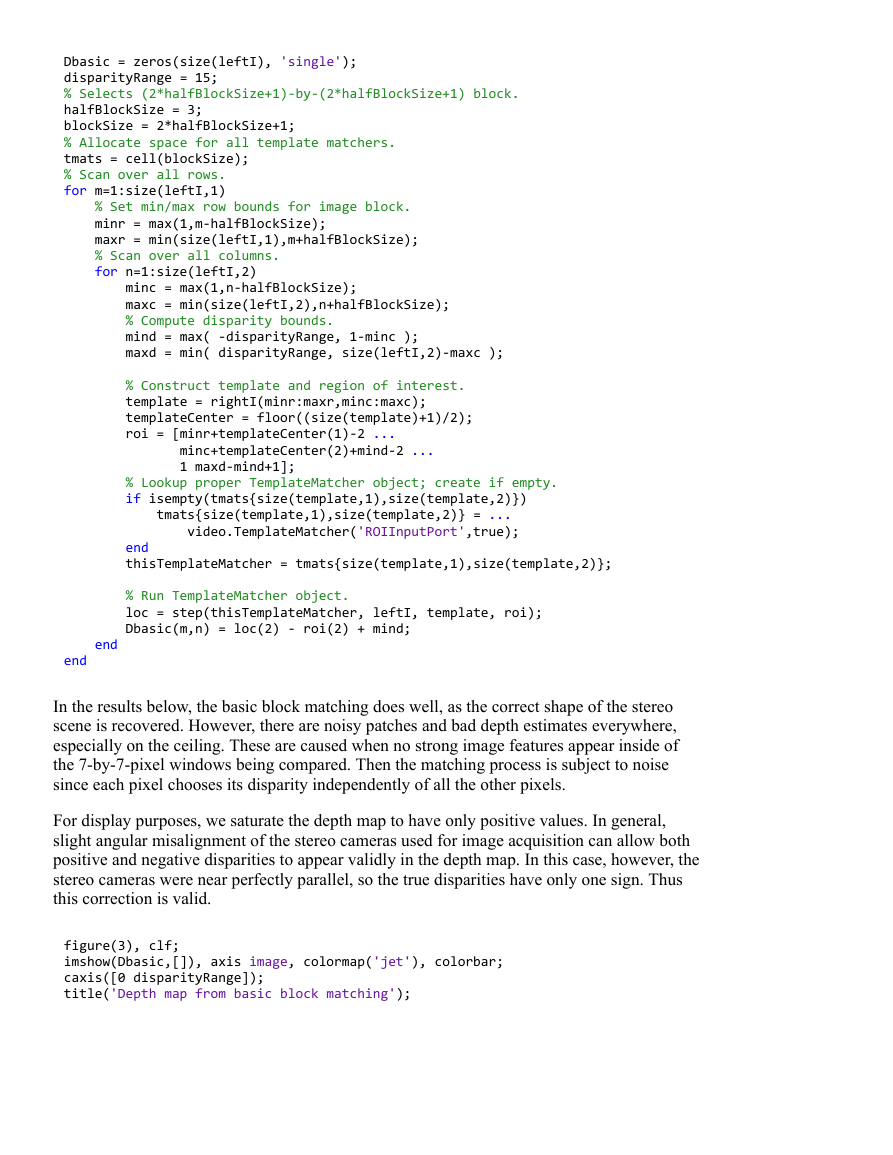

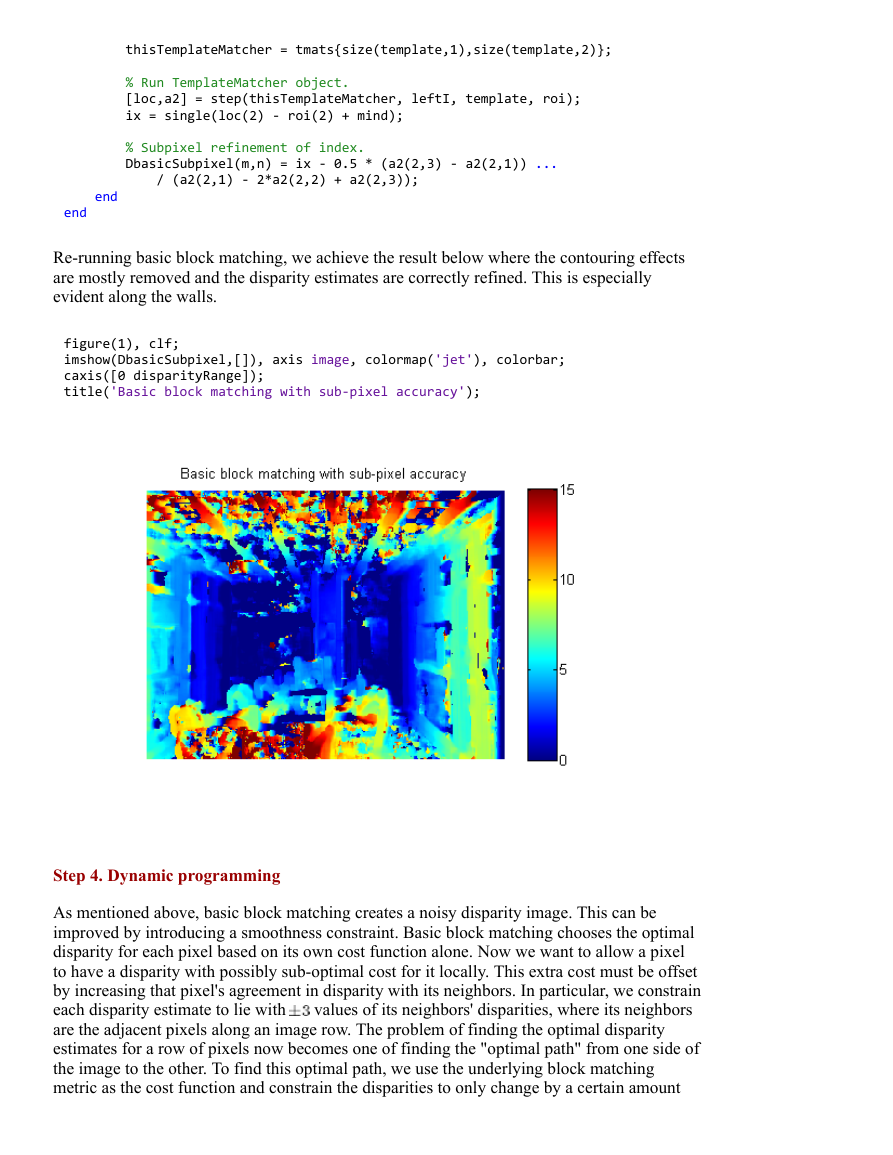
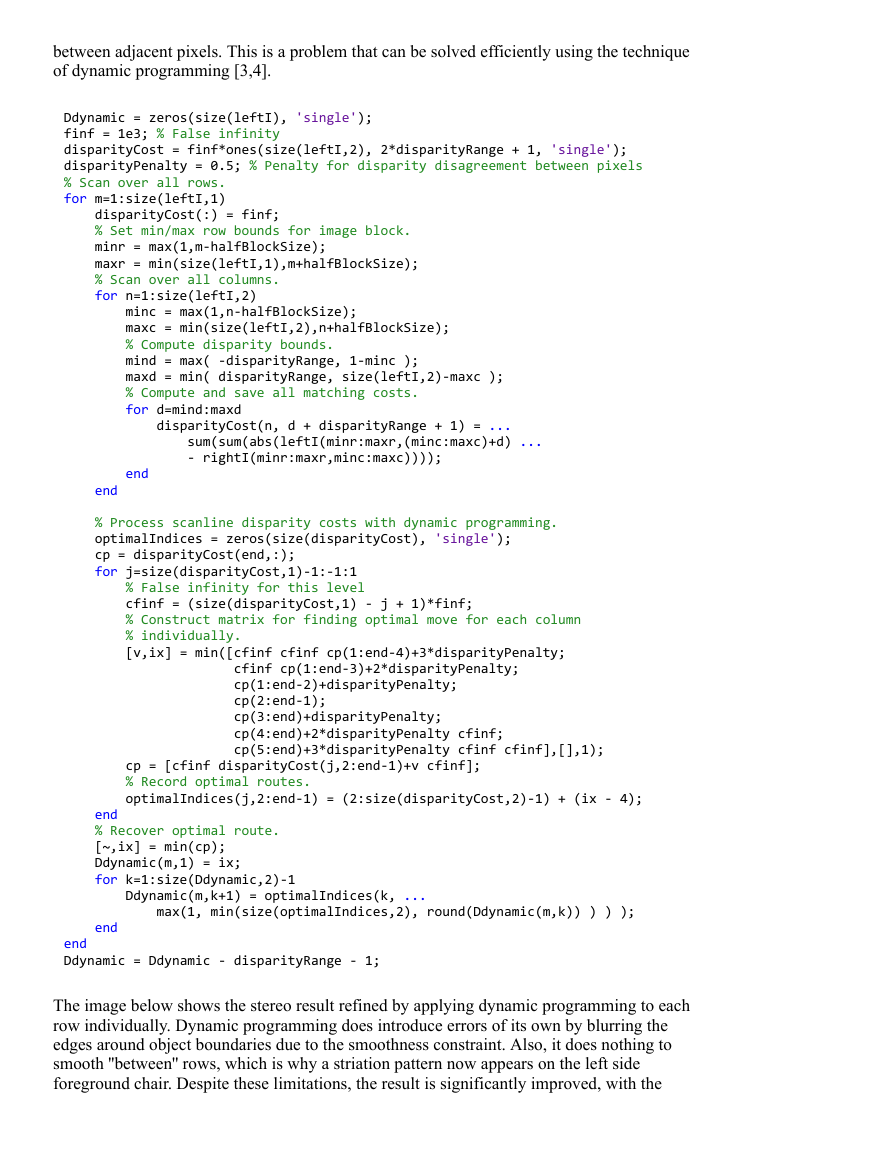
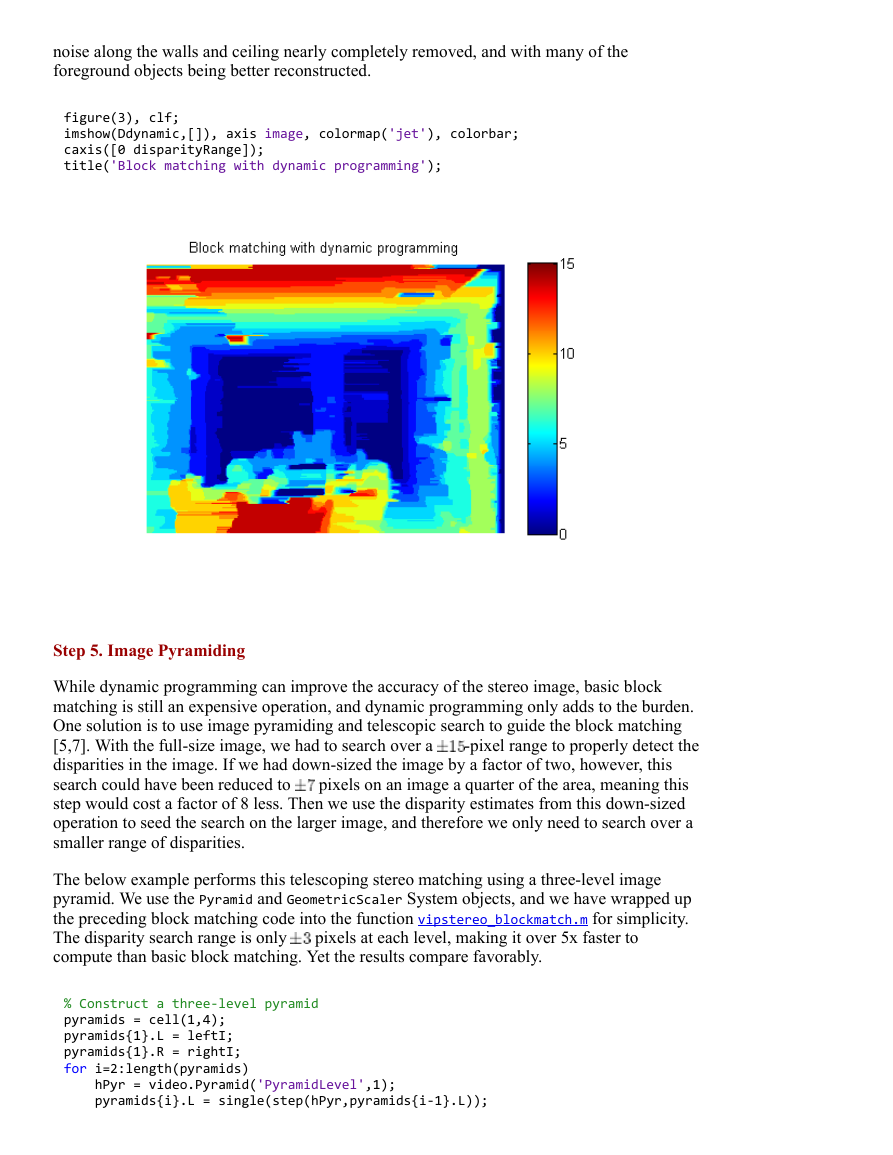
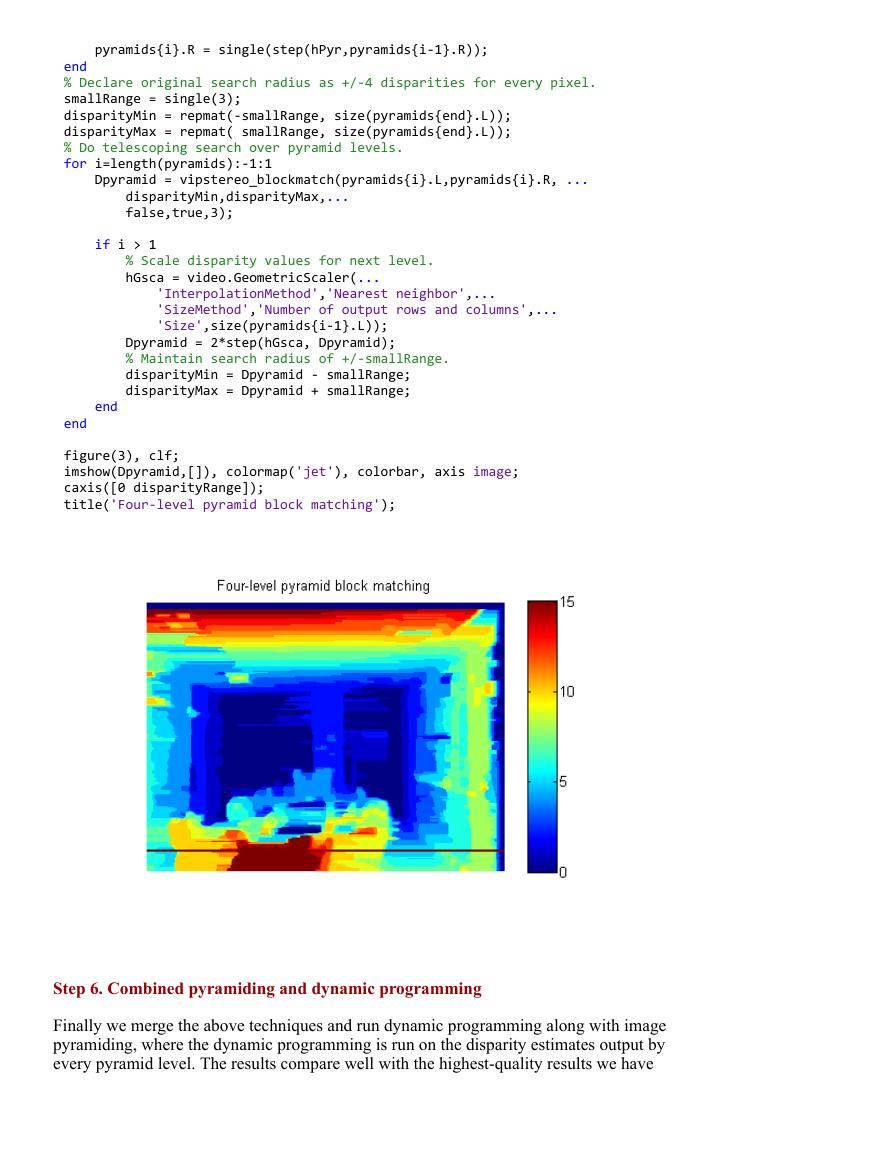








 2023年江西萍乡中考道德与法治真题及答案.doc
2023年江西萍乡中考道德与法治真题及答案.doc 2012年重庆南川中考生物真题及答案.doc
2012年重庆南川中考生物真题及答案.doc 2013年江西师范大学地理学综合及文艺理论基础考研真题.doc
2013年江西师范大学地理学综合及文艺理论基础考研真题.doc 2020年四川甘孜小升初语文真题及答案I卷.doc
2020年四川甘孜小升初语文真题及答案I卷.doc 2020年注册岩土工程师专业基础考试真题及答案.doc
2020年注册岩土工程师专业基础考试真题及答案.doc 2023-2024学年福建省厦门市九年级上学期数学月考试题及答案.doc
2023-2024学年福建省厦门市九年级上学期数学月考试题及答案.doc 2021-2022学年辽宁省沈阳市大东区九年级上学期语文期末试题及答案.doc
2021-2022学年辽宁省沈阳市大东区九年级上学期语文期末试题及答案.doc 2022-2023学年北京东城区初三第一学期物理期末试卷及答案.doc
2022-2023学年北京东城区初三第一学期物理期末试卷及答案.doc 2018上半年江西教师资格初中地理学科知识与教学能力真题及答案.doc
2018上半年江西教师资格初中地理学科知识与教学能力真题及答案.doc 2012年河北国家公务员申论考试真题及答案-省级.doc
2012年河北国家公务员申论考试真题及答案-省级.doc 2020-2021学年江苏省扬州市江都区邵樊片九年级上学期数学第一次质量检测试题及答案.doc
2020-2021学年江苏省扬州市江都区邵樊片九年级上学期数学第一次质量检测试题及答案.doc 2022下半年黑龙江教师资格证中学综合素质真题及答案.doc
2022下半年黑龙江教师资格证中学综合素质真题及答案.doc